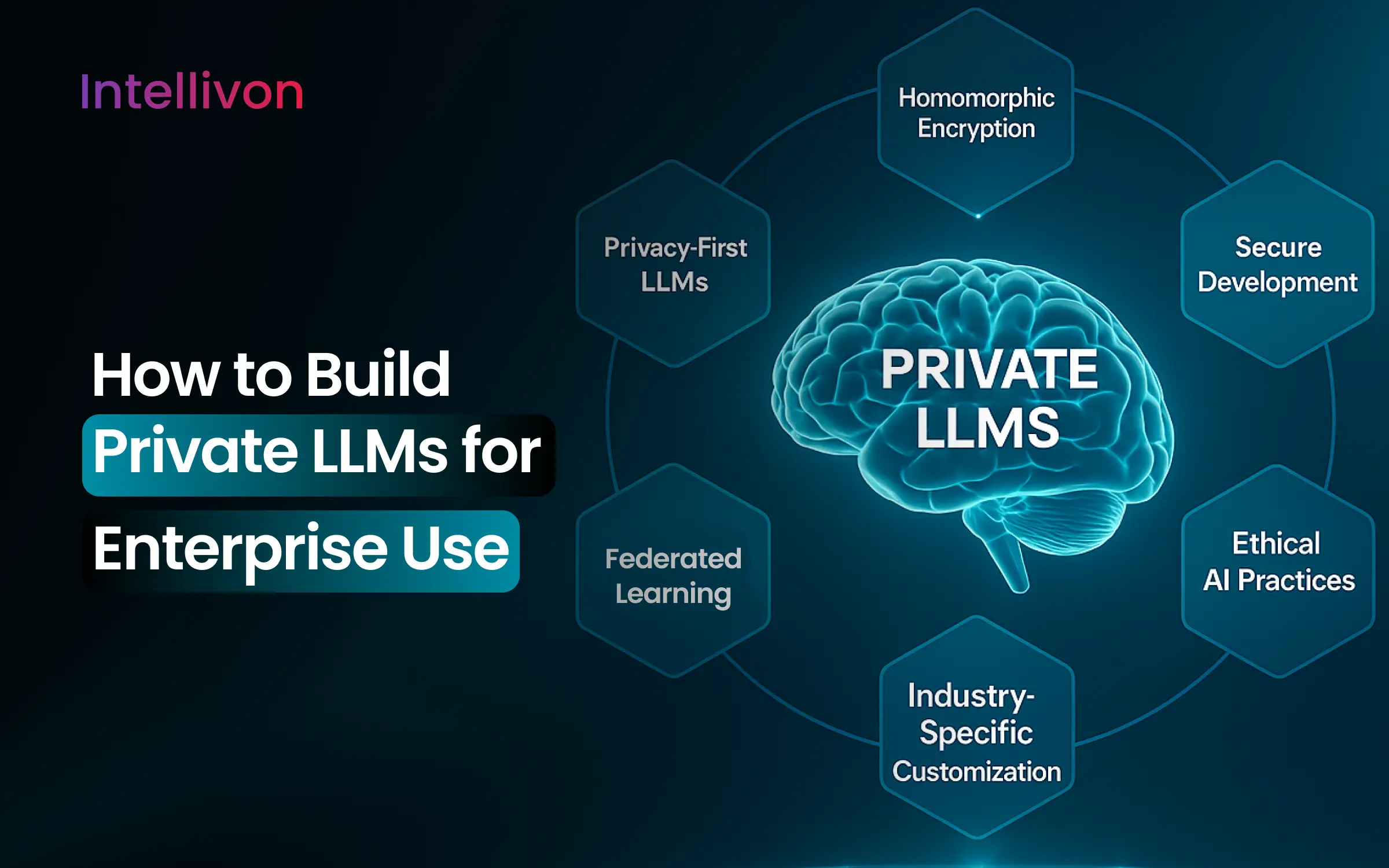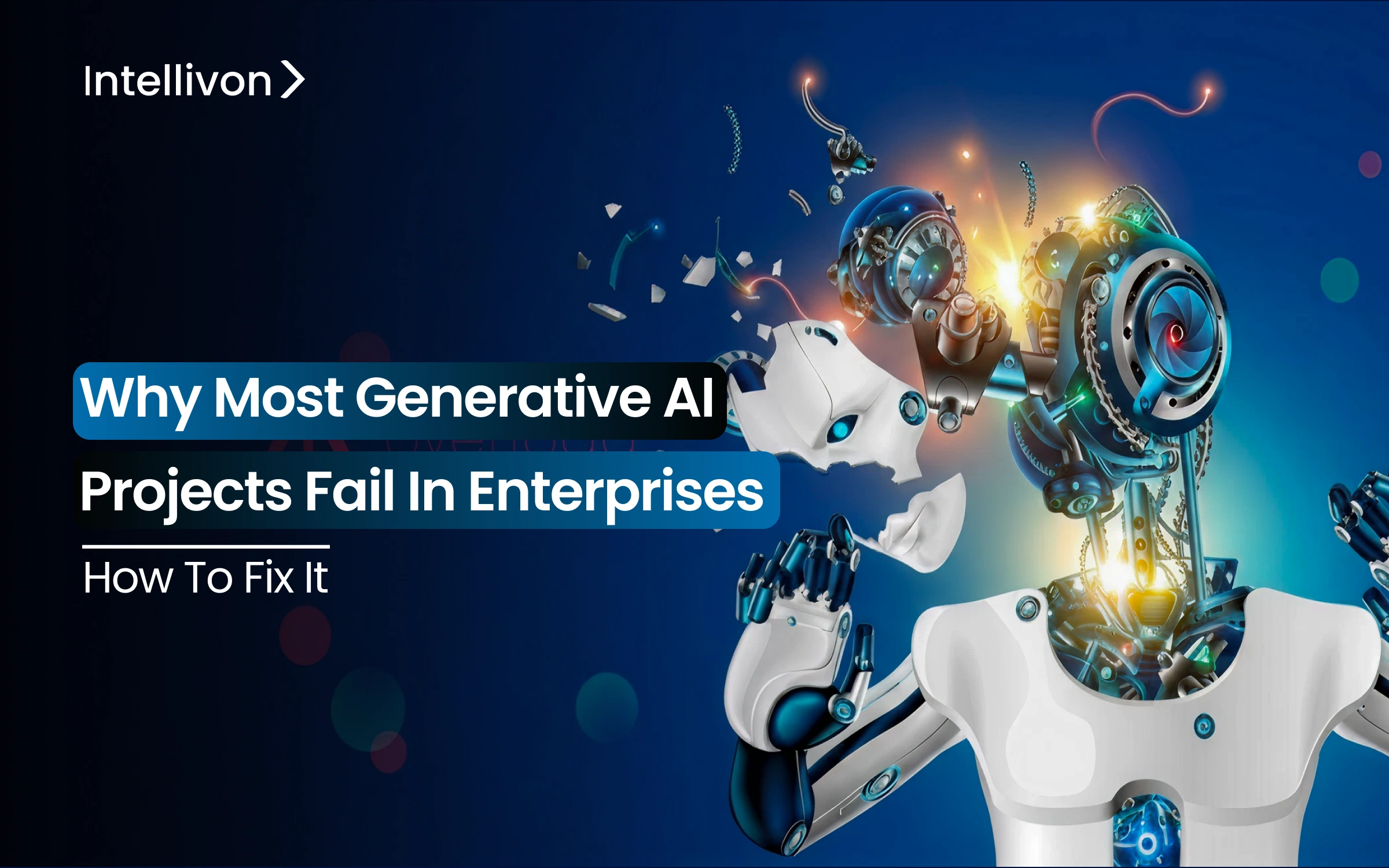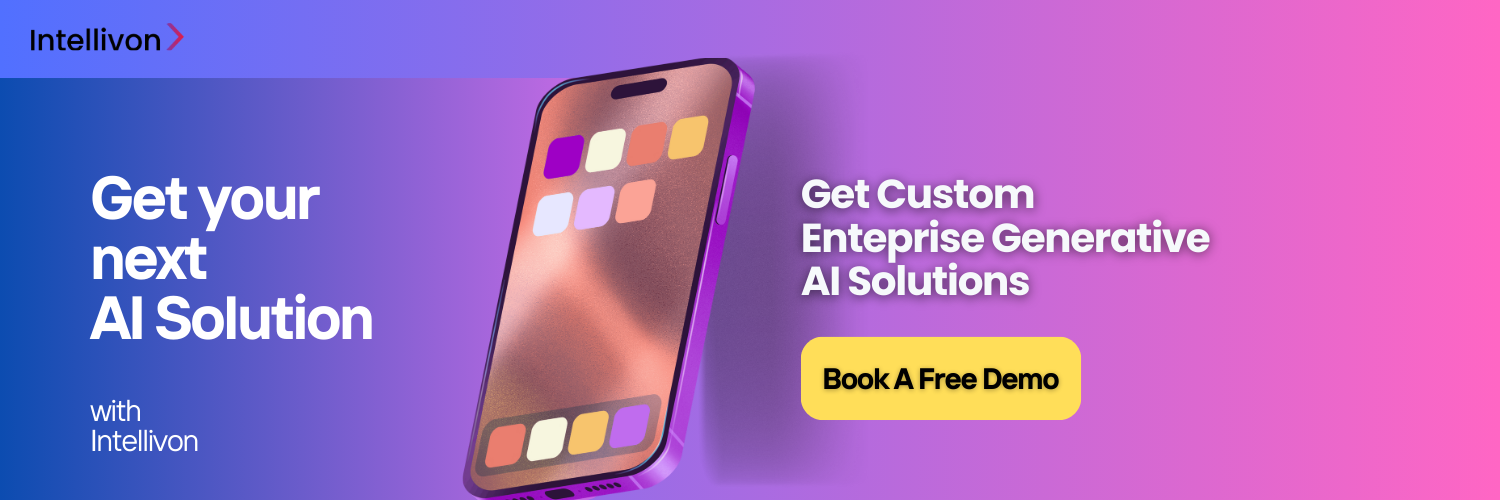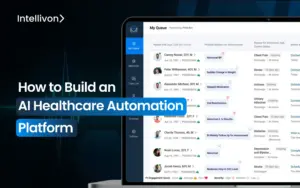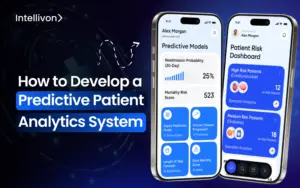When ChatGPT appeared in late 2022, excitement filled boardrooms around the world. Companies began racing to use the power of enterprise generative AI. This technology promised to change customer service, automate complex workflows, and boost productivity. It offered solutions to long-standing business challenges: cutting down on manual tasks, speeding up content creation, and making data-driven insights available to all employees.
However, beneath the initial hype is a harsh truth. A recent MIT report shows that 95% of generative AI projects fail despite companies pouring $30-40 billion into the technology. This is not a criticism of AI itself. Our work with Fortune 500 companies has revealed the real problem: organizational and strategic mistakes that undermine projects from the start.
At Intellivon, we’ve seen these patterns many times during enterprise implementations. While generative AI does play a role in some failures, most issues arise from poor planning, lack of change management, and unrealistic expectations. The successful 5% share strategies that turn pilot projects into profitable ventures. What distinguishes successful AI projects from the 95% stuck in limbo? Let’s explore the key factors that lead to this failure, how to fix it, and how we deliver these solutions for enterprises.
Understanding the Current Landscape of Generative AI Projects
Generative AI has gained attention for its huge potential, but the numbers tell a different story. Despite significant investments and enthusiasm, the failure rate of generative AI projects is shockingly high. Here’s a closer look at the surprising statistics:
- 30% of generative AI projects will be abandoned after the proof of concept by 2025.
- 95% of generative AI pilots fail to deliver meaningful business value.
- 42% of businesses will scrap most of their AI initiatives in 2025, up from just 17% the previous year.
- 70-85% of generative AI deployments fail to meet desired ROI, with many investments leading to zero returns.
- AI spending has surged to $13.8 billion, but much of this is not translating into returns.
- Over 50% of generative AI budgets go toward sales and marketing tools, despite back-office automation offering the biggest ROI.
- 21% of AI projects fail due to data privacy issues, while 18% fail due to disappointing ROI.
- Technical issues, like hallucinations in AI outputs, contribute to 15% of failures.
These statistics paint a grim picture, but there’s hope. Despite these challenges, some enterprises are finding their way to success with generative AI. In fact, a small but growing group of companies is bucking the trend and seeing substantial returns on their AI investments.
Success Stories
- Microsoft: Enterprise customers of Microsoft are achieving incredible results. For example, Lumen, a key client, reduced operational time from hours to just 15 minutes, saving an estimated $50 million annually. Microsoft’s Security Copilot at NTT Communications enabled faster talent upskilling and improved the efficiency of senior analysts.
- Salesforce: Salesforce’s AI tools have helped 85% of SMBs see a positive ROI. The company is ambitiously deploying 1 billion AI agents within a year through its Agentforce platform.
- Enterprise Startups: AI-first companies, often founded by young entrepreneurs, are seeing remarkable success. Some have gone from zero to $20 million in annual revenue in just a year by focusing on solving specific pain points with strategic partnerships.
While generative AI deployment faces significant hurdles, the future outlook remains positive. Gartner predicts that by 2026, 80% of enterprises will have used generative AI APIs or deployed AI-enabled applications in production, up from less than 5% in 2023.
However, success will depend on learning from current failures and implementing better strategies. The enterprises in the top 5% are doing just that by focusing on the right objectives, investing in data quality, and partnering with experts who can guide them through the complexities of AI deployment.
Where Generative AI Works and Where It Doesn’t
Companies dream that autonomous AI can perform any task without human input with the power of generative AI. However, the current reality is different.
Generative AI is powerful but can only supplement human workflows, not replace them entirely. To set realistic goals for AI projects, enterprises need to understand where generative AI fits and where it doesn’t. Here’s a breakdown of the problem spaces where generative AI excels and areas where it should not be used.
Comparison Table :
| Problem Spaces Suitable for Generative AI | Problem Spaces Not Suited for Generative AI |
| Content Generation: Writing articles, generating marketing copy, creating customer service scripts, drafting emails, producing art, enhancing photographs, generating design prototypes, creating music, voice synthesis, sound effects, generating animations, video summaries, and video effects. | Highly Regulated or Compliance-Critical Applications: Financial auditing, legal document drafting requiring precise compliance and deep expertise. |
| Language Translation and Summarization: Real-time translation of text and speech between multiple languages, condensing long documents, articles, or transcripts into concise summaries. | Real-Time Critical Decision-Making: Autonomous vehicles and medical diagnoses that require highly reliable and robust systems. |
| Conversational Agents: Providing customer support, answering FAQs, engaging users in dialogue, assisting with scheduling, reminders, and task management. | Sensitive and Confidential Data Handling: Applications involving PII or classified information require strict data privacy and security. |
| Personalization: Tailoring product suggestions, content recommendations, and personalized marketing, creating personalized content, experiences, and services based on user preferences. | Tasks Requiring Deep Domain Expertise and Human Judgment: Strategic business planning, complex narrative creative writing. |
| Creative Problem-Solving: Generating design concepts, architectural plans, and product prototypes, brainstorming new ideas, innovations, and creative solutions to complex problems. | Physical and Safety-Critical Systems: Manufacturing process control, critical infrastructure management. |
| Data Augmentation and Enhancement: Identifying and correcting errors or inconsistencies in datasets, creating synthetic data to augment existing datasets for training purposes. | Emotional and Social Intelligence: Human resources management, handling employee grievances, performance reviews, and customer service for sensitive issues. |
Understanding where generative AI works and where it doesn’t is key to setting realistic expectations and ensuring that AI projects deliver value.
Why Generative AI Enterprise Projects Fail
Generative AI has the potential to revolutionize industries, but the reality is that many enterprises are struggling to make it work. Despite huge investments, AI projects often fail to deliver the expected ROI.
The reasons for these failures are rarely about the technology itself. Instead, the root causes lie in poor planning, misaligned objectives, and challenges around data quality, regulation, and integration with existing systems. In this section, we’ll break down why generative AI projects fail in enterprises.
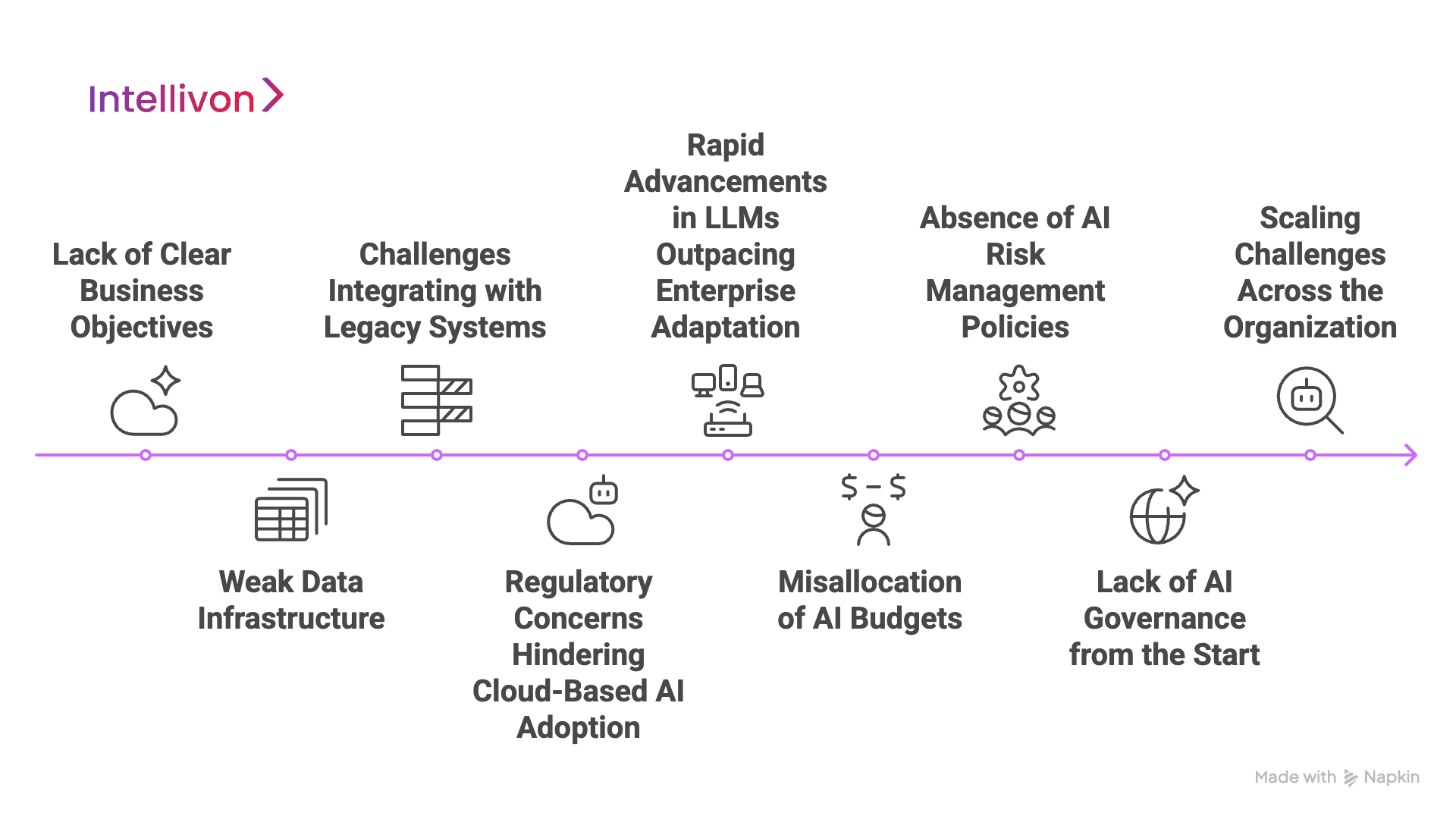
1. Lack of Clear Business Objectives and KPIs
Many AI projects fail because companies do not define clear business goals. AI is often adopted without aligning it to specific business needs. Without clear KPIs (Key Performance Indicators), it’s difficult to measure success.
A retailer used generative AI for customer service. But, without goals like improving customer satisfaction or reducing response time, the project lacked focus and delivered no measurable outcomes.
2. Weak Data Infrastructure
AI models need high-quality data to work effectively. Weak data infrastructure, which includes outdated systems, fragmented data, and inconsistent formats, makes it difficult for AI to deliver real value. If data isn’t structured properly, the AI cannot process it correctly, leading to inaccurate predictions and results. According to a recent study, 92.7% of executives cite data issues as a primary barrier to AI success. In addition, a staggering 99% of AI and machine learning projects face data gravity issues during deployment. This means that data is often too heavy or scattered across different systems, making it difficult to move or integrate it into AI models effectively.
IBM’s Watson for Oncology was a promising cancer care tool, but it failed when it recommended unsafe treatments, causing MD Anderson to abandon the project in 2016 after spending $62 million. Trained on synthetic data, the AI showed bias toward American patients, making it unsuitable for global use. Only a few dozen hospitals adopted the system, despite IBM’s goal to dominate the healthcare market
As a solution, enterprises can invest in modern data infrastructure. Use data lakes or data warehouses to centralize data. Ensure data quality through proper data governance and make it accessible for AI systems.
3. Challenges Integrating with Legacy Systems
Most enterprises face a harsh reality: their existing technology infrastructure wasn’t built to support AI. A comprehensive study by Economist Impact revealed that only 22% of organizations believe their current architecture can handle AI workloads without significant changes. These systems, built decades before modern AI capabilities, create a significant barrier. As a result, businesses often try to force-fit cutting-edge AI tools into outdated systems, creating inefficiencies that hinder project success.
The UK’s National Health Service (NHS) learned this lesson the hard way during its AI diagnostic rollout between 2019 and 2021. Despite investing millions in advanced AI tools, they encountered numerous challenges due to legacy IT systems. These included high maintenance costs, security vulnerabilities, and serious integration issues. This led to data bottlenecks and delayed patient outcomes, ultimately forcing them to scale back the program significantly.
The successful 5% of companies use middleware and APIs to bridge legacy systems with AI, focusing on phased integration and building a solid data management foundation. This gradual approach ensures infrastructure isn’t overwhelmed and aligns with business goals and budgets.
4. Regulatory Concerns Hindering Cloud-Based AI Adoption
Data privacy and regulatory compliance issues are major barriers, keeping AI projects stuck in pilot phases. While 85% of organizations use AI services, governance has lagged behind adoption, with only 18% having an enterprise-wide council to manage AI governance.
This creates a compliance gap that’s especially costly in regulated sectors like healthcare and finance, where 75% of GDPR-compliant AI systems report fewer data breaches and penalties.
The regulatory challenge is real. For example, Anthropic blocked access to its Claude AI for companies majority-owned by Chinese entities due to legal and security risks, showing how quickly AI initiatives can be disrupted. In healthcare, GDPR impacts how AI handles personal data, leading many organizations to avoid cloud-based AI, despite its potential benefits for patient care.
Enterprises need to adopt private LLMs or on-premises systems for better control over sensitive data. In regulated industries, involve legal and compliance teams from the start to avoid issues and improve AI outcomes.
5. Rapid Advancements in LLMs Outpacing Enterprise Adaptation
Generative AI is evolving quickly. As new LLMs are introduced, older versions can become obsolete almost overnight. Enterprises struggle to keep up with rapid technological changes, leading to increased costs and frequent updates that can disrupt projects.
Companies investing heavily in ChatGPT tools found themselves having to adapt constantly as newer versions, like GPT-4, were released. The rapid pace of change caused resource reallocation and low ROI.
Use an agile approach to AI development. Focus on iterative updates and ensure the system can adapt to new LLM advancements without requiring a complete overhaul.
6. Misallocation of AI Budgets
Many enterprises allocate their AI budgets toward front-office applications such as sales automation, marketing, and customer service. However, the highest ROI often comes from automating back-office repetitive processes like supply chain management and HR.
Example: A manufacturing company invested heavily in AI for marketing, but the biggest returns came from using AI to streamline inventory management, saving money on logistics and reducing stockouts.
Prioritize back-office automation where AI can make the biggest impact in enterprise operations. Analyze areas that can generate the highest returns and allocate resources accordingly.
7. Absence of AI Risk Management Policies
Enterprises that lack AI risk management policies often expose themselves to ethical dilemmas, security risks, and unintended consequences. Without policies to manage risks, AI projects can inadvertently create issues like data bias or privacy violations.
A retail brand deployed an AI pricing model without addressing bias in the data. This led to discriminatory pricing for some customers, resulting in a public backlash and loss of customer trust.
Develop a comprehensive AI risk management strategy. This should include ethics guidelines, regular audits, bias detection, and continuous monitoring to ensure AI operates within the bounds of regulations and ethical standards.
8. Lack of AI Governance from the Start
Many companies fail to establish AI governance early in the process. AI governance ensures that AI systems are used responsibly, fairly, and in a way that aligns with business and regulatory standards. Without proper oversight, AI projects may become misaligned with business goals or result in unintended errors.
Example: A financial institution deployed an AI model to detect fraud. However, without proper governance, the AI model produced false positives, disrupting customers’ financial transactions and causing frustration.
Implement AI governance frameworks from day one. Define clear roles and responsibilities to manage AI systems. Establish oversight to ensure AI models meet business needs and comply with regulations.
9. Scaling Challenges Across the Organization
Scaling AI across a large enterprise involves significant challenges. It requires strong coordination between departments, the right infrastructure, and clear strategies for deployment. Too often, AI projects work well in small teams but fail to scale to the larger organization.
A global retailer tested AI in one region but faced challenges in scaling it across different departments and countries. Different systems, varying regulations, and cultural resistance made it difficult to implement AI company-wide.
Foster cross-departmental collaboration. Invest in scalable AI infrastructure that can handle enterprise-wide deployment. Ensure that leadership teams and departments are aligned and committed to scaling AI initiatives.
By addressing these key hurdles, enterprises can avoid common pitfalls and position themselves for long-term AI success.
How the Top 5% Enterprises Avoid Generative AI Failures
A small group of companies has figured out how to succeed with generative AI. They know that AI isn’t just about technology. It’s about strategy, planning, and execution. This section explores how these companies overcome common pitfalls and how you can apply their strategies to make your AI projects succeed.
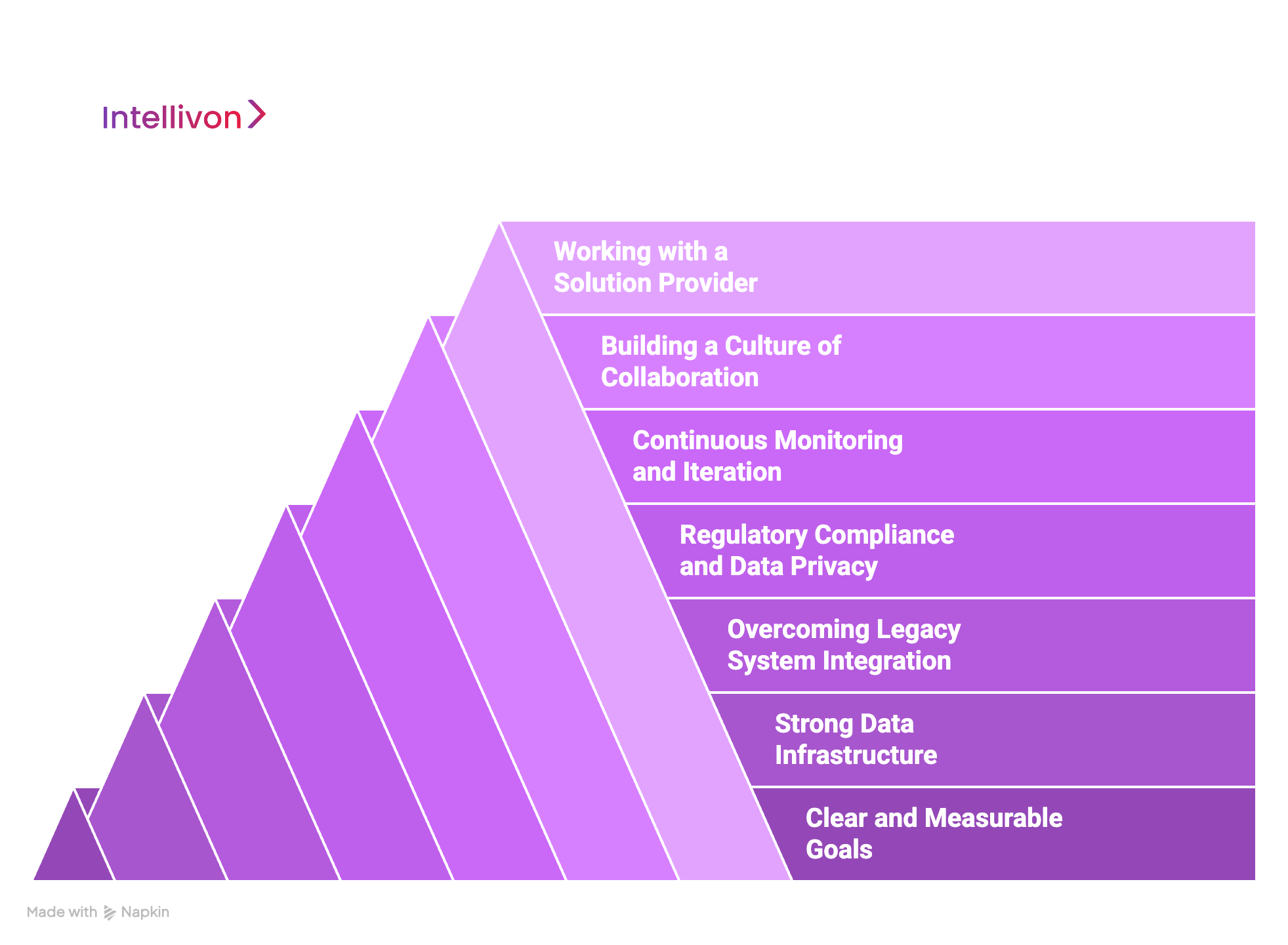
1. Clear and Measurable Goals
The top 5% set clear business objectives from the start. Many companies rush into AI projects without defining clear goals. This lack of direction leads to vague deployments that don’t align with business needs.
Whether improving customer service, generating marketing content, or automating operations, their goals are specific and measurable. For example, a global retailer might set a goal to reduce customer support response time by 50% in six months through an AI-powered chatbot. With this clear KPI, the company can track progress, identify challenges, and adjust its approach.
The top companies also ensure AI aligns with long-term business goals. Instead of treating AI as an isolated tool, they integrate it into the overall business strategy.
2. Strong Data Infrastructure
Many enterprises fail with AI due to weak data infrastructure. AI needs vast amounts of clean, organized data. When data is fragmented, unstructured, or outdated, AI can’t work effectively. Research shows that 92.7% of executives cite data issues as a major barrier to AI success.
Top enterprises make data quality and accessibility a priority. They invest in modernizing their infrastructure by building data lakes or data warehouses to centralize data. They focus on eliminating silos and ensuring data consistency, which boosts AI model accuracy.
By creating a data-first approach, these companies ensure their AI models can process clean data, resulting in better insights. They also set up data governance frameworks to meet privacy and compliance standards.
3. Overcoming Legacy System Integration
Integrating new AI tools with old systems is a huge hurdle. Many businesses still use outdated legacy systems that weren’t designed for modern AI. Trying to force AI tools into these old systems leads to inefficiency and failure.
The top enterprises take a strategic approach. Instead of overhauling everything at once, they start with non-critical systems and use middleware or APIs to connect AI with legacy tools. This ensures smooth data flow and reduces disruption.
In many cases, businesses can also leverage Robotic Process Automation (RPA) to interact with legacy systems. RPA can automate tasks such as logging into UI interfaces, extracting data, and transferring it into structured formats (like CSV files) that AI systems can process. This allows companies to bypass system limitations without the need for complex, costly upgrades.
For example, a financial services company might begin by integrating AI into customer service. They can use RPA to automate data extraction from legacy CRM systems and then gradually expand AI’s role into more complex areas, like risk management. This phased approach reduces risk, ensures the AI system is thoroughly tested, and guarantees a smooth transition to more critical processes.
4. Regulatory Compliance and Data Privacy
Regulatory compliance is one of the most common hurdles for generative AI projects. Many industries, such as healthcare and finance, are highly regulated, making AI implementation difficult. Concerns about data privacy further complicate matters. Cloud-based AI models often don’t meet strict compliance standards, leaving many companies hesitant to move forward.
Top enterprises see compliance as an advantage, not a barrier. They embed compliance frameworks from the start. For example, they choose private LLMs (Large Language Models) or on-premise AI systems to maintain better control over sensitive data, rather than relying on public cloud models.
In industries like healthcare, GDPR-compliant AI systems are critical. A regional healthcare system used an AI-based predictive analytics platform to streamline regulatory compliance, cutting audit preparation time by 70%. This shows how AI can simplify compliance tasks.
Moreover, top companies involve legal and compliance teams early, rather than waiting until deployment. This ensures AI projects meet all legal and regulatory requirements from day one.
5. Continuous Monitoring and Iteration
The top 5% understand that AI is a continuous journey. Generative AI models require regular monitoring, maintenance, and iteration to stay aligned with business goals. AI models can easily become outdated or inaccurate if not consistently trained or adjusted to meet evolving business needs.
For instance, a global e-commerce platform might use AI to recommend products. As customer preferences change over time, the AI model must be updated to stay relevant. Top companies prioritize ongoing training and optimization to ensure that their AI systems deliver consistent value.
By tracking AI performance and iterating on feedback, businesses ensure that their AI tools stay relevant and effective in the long term.
6. Building a Culture of Collaboration
AI adoption is not just an IT project. Fostering a collaborative culture across departments is essential. AI impacts various areas of business, from marketing to HR to operations. The top companies ensure that all departments, like business leaders, data scientists, and IT professionals, work together on AI projects.
For example, a company might create cross-functional teams to test AI tools and gather feedback from different departments. This ensures that AI aligns with real-world needs and drives business value. By creating an environment of collaboration, these companies make sure AI isn’t siloed but integrated across the organization.
7. Working with a Solution Provider
For many enterprises, working with an experienced AI solution provider is a game-changer. Intellivon, for instance, specializes in custom AI solutions designed to meet each enterprise’s specific needs. AI isn’t a one-size-fits-all solution. A provider with experience can build AI tools that speak the unique voice of your business and integrate seamlessly with existing systems.
By working with a skilled provider, companies can avoid the common pitfalls that derail AI projects. Intellivon helps ensure that AI is aligned with business goals, operates effectively within the existing infrastructure, and complies with regulatory standards. With tailored solutions, companies can unlock the full potential of generative AI while avoiding costly mistakes.
By following these best practices, companies can avoid common pitfalls and position themselves for long-term AI success.
Our Architecture for Successful Enterprise Generative AI Implementation
At Intellivon, we recognize that implementing generative AI requires more than just deploying advanced models. It’s about building a robust, scalable, and secure AI architecture that integrates with your existing infrastructure and meets your business objectives. Here’s how we design enterprise-grade generative AI solutions:
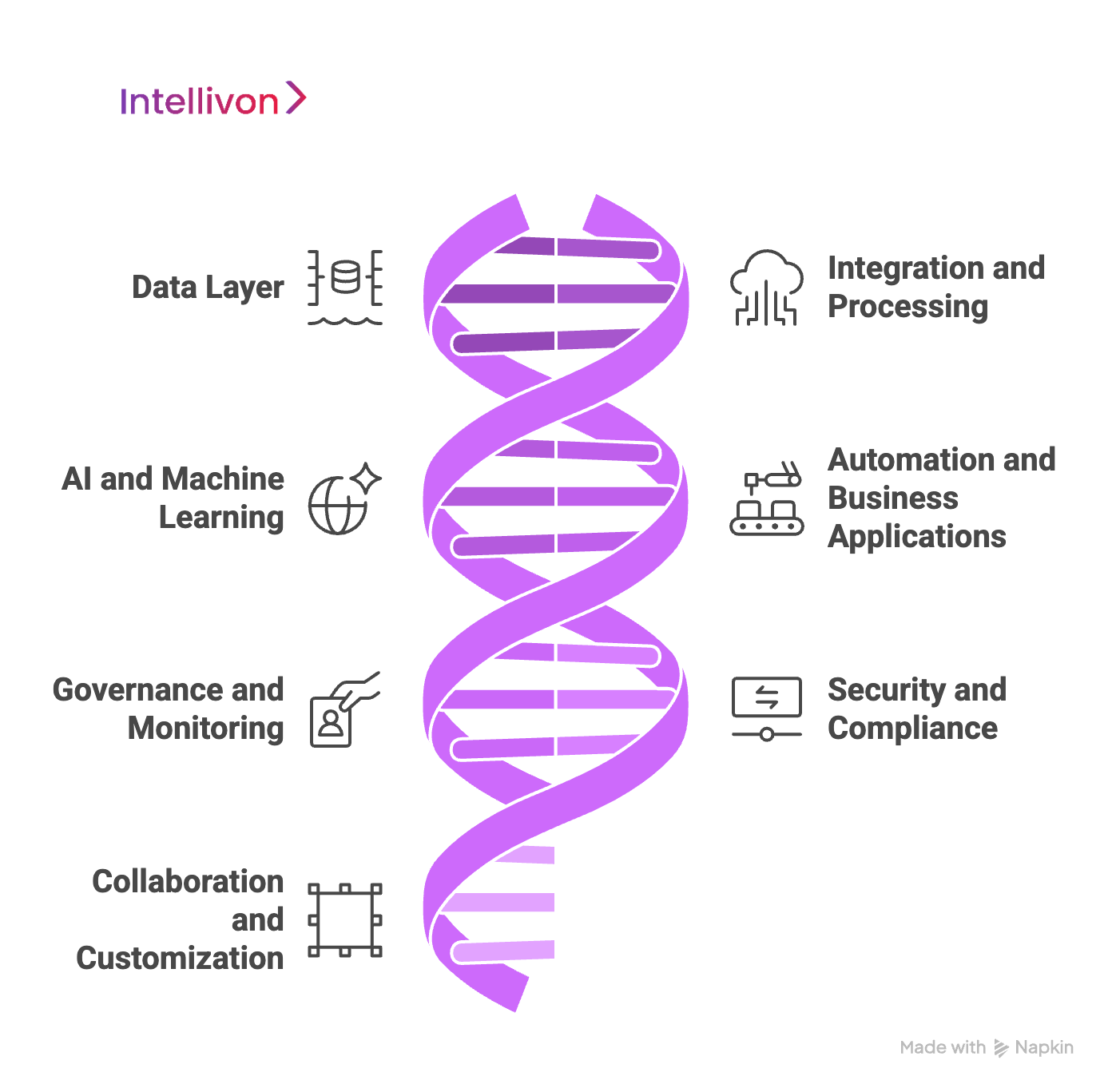
1. Data Layer
Data is the foundation of any AI system. We begin by establishing a solid data layer that gathers data from diverse sources like internal repositories, IoT sensors, and third-party APIs. The data is then carefully validated and cleansed to ensure its quality and reliability.
To manage this data efficiently, we implement secure, scalable storage solutions, whether on-premises or in the cloud. By centralizing this data, we make it easily accessible for AI models, ensuring that it is ready for analysis and training.
2. Integration and Processing Layer
The next step is to extract value from the data. We use AI-powered ETL (Extract, Transform, Load) pipelines to automate the processing of large data sets, ensuring accuracy and efficiency. These pipelines help harmonize data from various sources and prepare it for AI consumption.
We also apply intelligent data processing techniques like feature engineering and anomaly detection, enhancing the quality of data fed into AI models. This ensures that the data is not just integrated, but fully optimized for AI applications.
3. AI and Machine Learning Layer
The heart of our architecture lies in the AI and machine learning layer. Here, we train, deploy, and continuously optimize predictive models. We use supervised, unsupervised, and reinforcement learning to extract insights and support data-driven decisions across business functions.
For complex tasks like natural language processing and computer vision, we leverage deep neural networks. Our models are scalable and adaptable, designed to handle diverse business needs. We also implement model governance frameworks to ensure transparency, fairness, and alignment with organizational goals.
4. Automation and Business Applications Layer
Once the AI models are ready, we integrate them into business applications where they create real-world value. This integration happens through APIs and intuitive interfaces, enabling seamless interaction with AI features.
For example, we use natural language processing models to automate customer support, improving efficiency and customer satisfaction. Similarly, computer vision models are implemented for quality control in manufacturing. This layer turns AI-generated insights into actionable results, driving business performance.
5. Governance and Monitoring Layer
Responsible AI use is crucial. Our governance and monitoring layer establishes the necessary policies, standards, and controls to oversee AI deployments. We set up centralized AI centers of excellence to monitor model performance, conduct fairness audits, and assess explainability.
We also implement automated alerts to detect issues like model drift, data quality concerns, and bias. This proactive monitoring allows for timely interventions, ensuring that AI systems operate ethically and in compliance with regulatory standards.
6. Security and Compliance Layer
Security is an integral part of any AI architecture. We apply multi-layered cybersecurity measures, including access controls, anomaly detection, and automated vulnerability patching, to protect your data, models, and infrastructure.
We also prioritize data privacy in industries like healthcare and finance, where strict regulations apply. Our solutions are designed to comply with standards such as GDPR and HIPAA, ensuring that sensitive data remains secure and compliant.
7. Collaboration and Customization Layer
We understand that each enterprise has unique needs. That’s why our AI architecture includes a collaboration and customization layer. We work closely with your teams to understand your specific goals and tailor AI solutions to meet them.
Our flexible architecture is designed to scale with your business, and we provide ongoing training and support to ensure your team can fully leverage AI. This collaborative approach ensures that AI aligns with your business objectives and creates personalized value.
Our architecture ensures that AI models are not only powerful but also integrate seamlessly into your enterprise systems, enhance data-driven decision-making, and stay compliant with industry regulations.
Our Process for Building and Deploying Enterprise Generative AI Solutions
At Intellivon, we take a tailored, step-by-step approach to building and deploying generative AI solutions that drive measurable outcomes. Our process combines industry expertise, advanced technology, and collaborative partnerships to ensure your AI project delivers value from day one. Here’s how we do it:
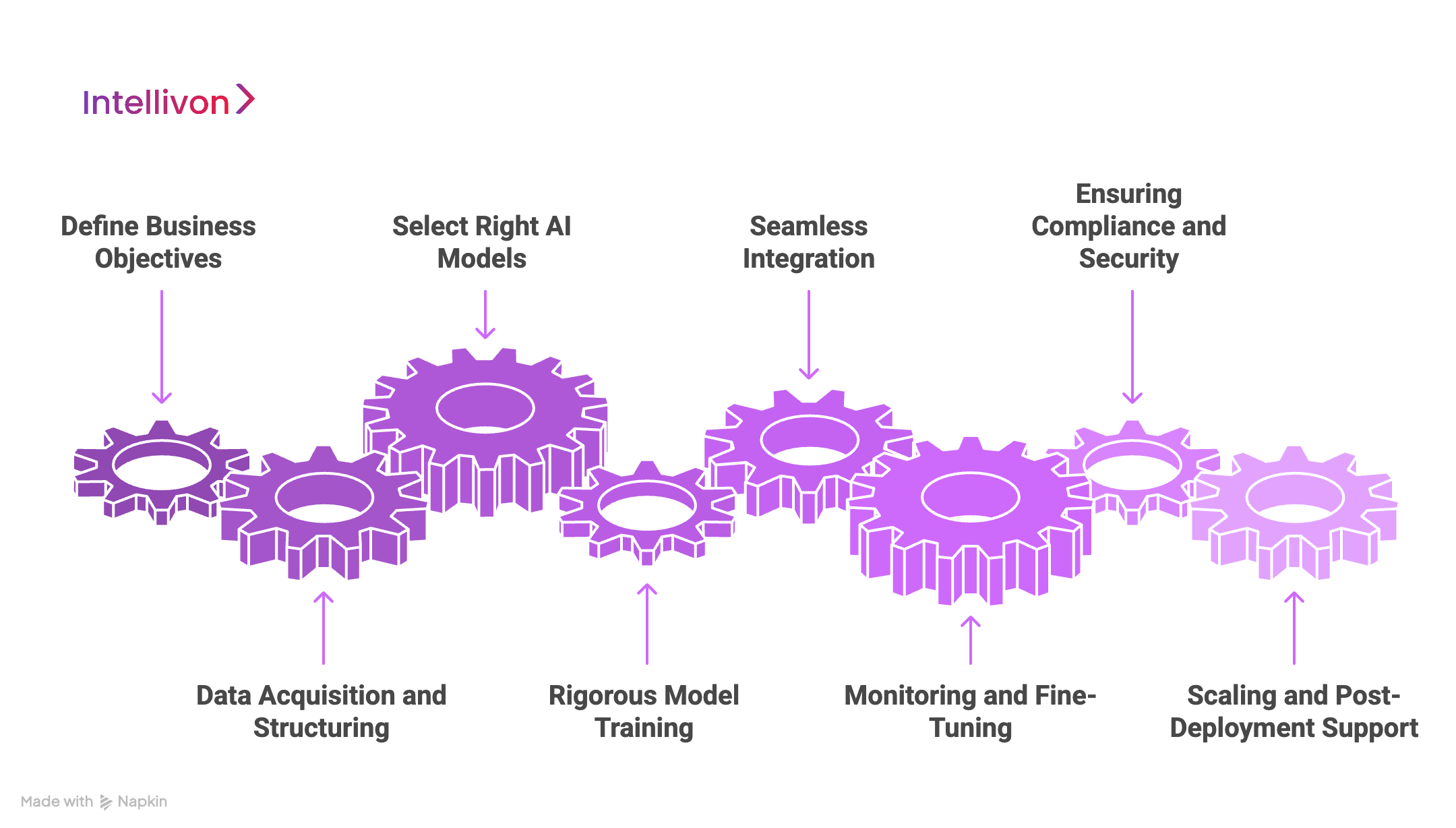
1. Defining Business Objectives
Every successful generative AI project starts with a clear business objective. We don’t believe in generic goals; instead, we work closely with you to identify specific KPIs that reflect your business challenges. Whether you’re aiming to reduce customer service response times, improve demand forecasting, or automate repetitive tasks, we help you articulate goals that are tangible, measurable, and aligned with broader business strategies.
AI projects that don’t have clearly defined outcomes risk becoming isolated experiments rather than meaningful tools. Intellivon ensures that each AI initiative is directly tied to business value and that success can be tracked from day one.
2. Data Acquisition and Structuring
Data is the lifeblood of AI, and without clean, structured data, even the best AI models will underperform. We begin by conducting a thorough audit of your data landscape. We assess internal data sources (like CRM systems, transactional data, and sensor data) and identify external sources (e.g., third-party APIs, social media).
Once data is gathered, we clean, normalize, and structure it for AI consumption. At Intellivon, we go beyond simple data collection and implement data pipelines using technologies like Apache NiFi or Fivetran to automate data flow, ensuring your data is always fresh and accurate.
This ensures AI models are built on a solid foundation of clean, reliable data, leading to better insights and outcomes.
3. Selecting Right AI Models
Generative AI isn’t “one-size-fits-all.” Each enterprise challenge requires the right AI model for the job. At Intellivon, we don’t just pick a pre-built model; we assess the best fit based on the specific business case.
For NLP tasks like content generation or chatbots, we may use transformers like GPT or T5. For tasks like product inspection in manufacturing, we use computer vision models built on CNNs (Convolutional Neural Networks). This step involves a blend of supervised learning, unsupervised learning, or even reinforcement learning, depending on the task.
After selecting the model, we focus on customization—fine-tuning pre-trained models or building models from scratch tailored to your domain. For instance, we can retrain GPT models with your proprietary data to align the model with your business language.
4. Rigorous Model Training
Once the model is selected and customized, we dive into training. Using the prepared data, we train the models on cloud infrastructures like Google Cloud AI Platform or AWS SageMaker, ensuring scalability. Throughout the training process, we use hyperparameter optimization techniques to ensure the model is learning effectively.
Once training is complete, we move to model validation. We test the model with real-world data and evaluate its performance against predefined KPIs. For example, we might test a customer support chatbot‘s response accuracy and engagement rates with actual user data. This testing phase helps us identify issues, make necessary adjustments, and ensure that the model is ready for deployment.
5. Seamless Integration
AI models are only as useful as their ability to integrate with existing business workflows. At Intellivon, we ensure that our generative AI models are seamlessly embedded into the tools and systems your teams already use.
Whether it’s integrating AI-powered chatbots into Zendesk or incorporating predictive analytics into your ERP system, we use APIs, middleware, and custom connectors to ensure that AI outputs are easily actionable. We ensure that the AI models integrate with existing processes without disrupting ongoing operations.
Our goal is to make AI an integral part of your workflow, not just a separate tool.
6. Monitoring and Fine-Tuning
AI is not static. To maintain its effectiveness, AI systems need ongoing monitoring and optimization. We set up real-time dashboards to track the performance of AI models and ensure they’re continually aligned with business objectives.
We use platforms like WhyLabs and Fiddler AI to monitor for model drift and ensure that AI systems don’t become outdated or ineffective over time. If the system detects performance issues, we retrain models or fine-tune parameters to adapt to new business data, market conditions, or regulatory changes.
This proactive monitoring ensures that AI continues to deliver value, preventing performance degradation.
7. Ensuring Compliance and Security
Generative AI solutions often involve sensitive data, which makes compliance and security non-negotiable. We implement data encryption techniques and ensure our AI models comply with industry regulations, such as GDPR for data privacy and HIPAA for healthcare.
We work closely with your legal and compliance teams to build in these requirements from day one, ensuring that every AI solution we deploy meets the highest standards of security and data governance.
This way, you can scale your AI projects without worrying about compliance risks or data breaches.
8. Scaling and Post-Deployment Support
The final step is ensuring that your AI system can scale and evolve with your business. At Intellivon, we don’t just stop after deployment. We offer scalable solutions that adapt as your business grows, ensuring that our AI systems can handle increased data, more users, or new functionalities as your business evolves.
Moreover, we provide ongoing support to address any challenges that arise post-deployment. Whether you need to adjust for market changes or optimize for new KPIs, Intellivon remains your partner in ensuring continuous success.
At Intellivon, we follow an efficient, targeted 8-step process to ensure that your generative AI projects not only meet your immediate needs but continue to evolve and scale over time. From clear goal-setting to ongoing optimization, we guide you every step of the way, turning AI from a technology experiment into a business-driving force.
Top Enterprises Successfully Deploying Generative AI Projects
Generative AI is revolutionizing industries, and some of the world’s top enterprises are leading the charge with impressive returns. Below, we highlight five companies that are deploying generative AI projects successfully.
1. JPMorgan Chase: The AI Banking Pioneer
JPMorgan Chase is a leader in AI-driven banking, with AI solutions contributing significantly to its bottom line. In 2024, JPMorgan is expecting nearly $2 billion in returns from its AI investments, particularly in fraud prevention. The bank has already implemented 450 proofs of concept, a number expected to climb to 1,000 by next year.
Their AI-powered trading analysis has led to a 20% increase in gross sales from 2023 to 2024. By identifying revenue opportunities and delivering personalized strategies, JPMorgan enhances client satisfaction, further solidifying the value of AI investments. With $9 billion invested in technology, product, and design this year, JPMorgan demonstrates that strategic AI investment drives measurable returns.
2. Microsoft: Enterprise AI Leadership
Microsoft continues to set the standard for AI in the enterprise space. Their AI-powered solutions are yielding dramatic results for enterprise customers, with Lumen reducing operational time from hours to just 15 minutes, saving $50 million annually.
Microsoft’s Security Copilot at NTT Communications has accelerated talent upskilling and improved senior analyst efficiency. According to Microsoft, 92% of early AI adopters report significant ROI, with businesses seeing 25-40% productivity improvements across various functions. This success shows how enterprise AI leadership can drive substantial returns through efficiency and productivity gains.
3. Salesforce: SMB AI Success at Scale
Salesforce is a leader in helping small and medium businesses (SMBs) scale with AI. Their Agentforce platform has helped 85% of SMBs using Salesforce AI solutions achieve positive ROI. In fact, Salesforce’s Einstein AI platform has delivered impressive results, including an average 27% increase in sales productivity and 35% faster case resolution in customer service.
With ambitious goals of deploying 1 billion enterprise AI agents within a year, Salesforce continues to make AI accessible and effective for businesses of all sizes. This success demonstrates how AI can scale for SMBs, delivering tangible improvements in sales and customer service.
4. Manufacturing Leaders: General Electric
In the manufacturing sector, AI-powered predictive maintenance is generating remarkable returns. Companies utilizing these models have reduced downtime by up to 35%, saving millions annually.
For example, General Electric (GE) has implemented digital twin technology, combining it with AI analytics to assist aerospace customers in reducing unplanned maintenance by 45%.
This innovation extends the equipment life by 20%, translating to hundreds of millions in cost savings for GE’s customer base. This illustrates how AI-powered predictive maintenance is transforming manufacturing by improving efficiency and cost savings.
5. Retail Giants: Personalization Powerhouses
Amazon’s recommendation engine, powered by advanced AI, drives about 35% of its total revenue, contributing to more than $140 billion in annual sales.
Similarly, Netflix’s AI-driven content recommendations save the company an estimated $1 billion per year by reducing churn and increasing viewer engagement.
These top enterprises demonstrate the power of generative AI in driving tangible business value across industries. From fraud prevention in banking to predictive maintenance in manufacturing, AI is transforming how companies operate and compete. By following their example, enterprises can unlock the full potential of generative AI, leading to increased efficiency, higher revenues, and measurable ROI.
At Intellivon, we help businesses like yours leverage generative AI to achieve similar success, tailored to your specific business needs and objectives.
Conclusion
Generative AI projects in businesses often fail because of unclear goals, poor data quality, integration issues, and a lack of regulatory compliance. However, the top 5% of businesses succeed by setting clear objectives, creating strong data infrastructures, and ensuring smooth integration.
By taking a strategic, step-by-step approach and partnering with experienced providers, companies can tackle these challenges and realize AI’s full potential for long-term success and measurable return on investment.
Build Your Next Successful Generative AI Solution With Intellivon
At Intellivon, we specialize in creating custom generative AI solutions tailored to meet the unique demands of your business. With over 11 years of experience, we help enterprises boost productivity, decision-making, and efficiency through AI-powered solutions designed for scalability, security, and long-term success.
Why Choose Intellivon for Your Generative AI Solution?
- Tailored Solution Design: We design AI models that integrate seamlessly into your workflows, addressing your specific business needs.
- Future-Ready Integrations: Connect AI with your existing systems like CRM, ERP, and BI platforms, ensuring a cohesive enterprise environment.
- Enterprise-Grade Security: We prioritize data privacy, encryption, and regulatory compliance to safeguard your operations.
- Optimized Cost Efficiency: Our proven frameworks reduce time-to-market while ensuring top-tier quality.
- Scalability for Growth: Our solutions evolve with your business, from initial deployment to full-scale integration.
Our AI Experts Are Here to Help You:
- Define your AI needs based on business objectives.
- Build scalable, modular AI solutions.
- Provide clear cost estimates and timelines.
- Develop, test, and deploy your AI solution with ongoing support.
Book your free consultation today and start building the AI-driven future your business deserves. Let’s unlock the power of Generative AI together.
FAQ’s
Q1. Why do most generative AI projects fail in enterprises?
A1. The majority of generative AI projects fail due to unclear goals, poor data quality, integration issues with legacy systems, and a lack of regulatory compliance. These challenges prevent AI solutions from delivering measurable results and business value.
Q2. How can enterprises ensure their AI projects succeed?
A2. To succeed, enterprises should set clear goals, build a strong data infrastructure, and ensure seamless integration with existing systems. Collaborating with experienced AI solution providers helps avoid common pitfalls and ensures long-term success.
Q3. What are the benefits of working with an AI solution provider like Intellivon?
A3. Working with Intellivon ensures that AI solutions are customized to meet your unique business needs, integrated smoothly with existing systems, and scalable for future growth. We prioritize security, compliance, and cost efficiency for every project.
Q4. How does AI improve business operations?
A4. AI enhances business operations by automating repetitive tasks, improving decision-making, and increasing productivity. It can streamline processes like customer service, sales forecasting, and inventory management, allowing teams to focus on high-impact work.
Q5. How do AI solutions scale with business growth?
A5. AI solutions are designed to scale by adapting to increased data volumes, users, and functionalities. At Intellivon, we ensure that AI models evolve with your business needs, allowing for easy integration and optimization as your enterprise grows.

